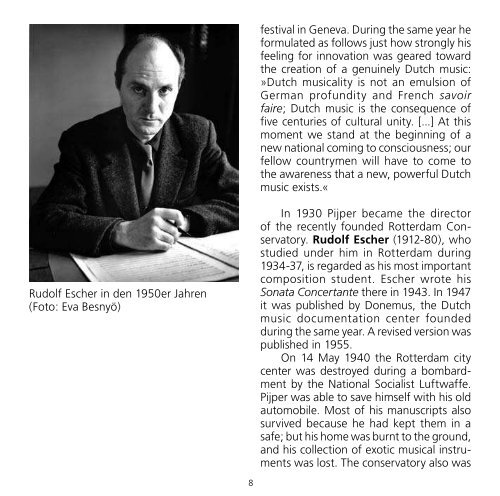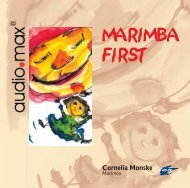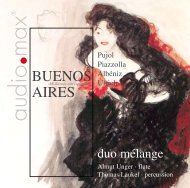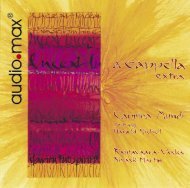Dutch Cello Sonatas - MDG Dabringhaus und Grimm
Dutch Cello Sonatas - MDG Dabringhaus und Grimm
Dutch Cello Sonatas - MDG Dabringhaus und Grimm
Sie wollen auch ein ePaper? Erhöhen Sie die Reichweite Ihrer Titel.
YUMPU macht aus Druck-PDFs automatisch weboptimierte ePaper, die Google liebt.
Rudolf Escher in den 1950er Jahren<br />
(Foto: Eva Besnyö)<br />
festival in Geneva. During the same year he<br />
formulated as follows just how strongly his<br />
feeling for innovation was geared toward<br />
the creation of a genuinely <strong>Dutch</strong> music:<br />
»<strong>Dutch</strong> musicality is not an emulsion of<br />
German prof<strong>und</strong>ity and French savoir<br />
faire; <strong>Dutch</strong> music is the consequence of<br />
five centuries of cultural unity. [...] At this<br />
moment we stand at the beginning of a<br />
new national coming to consciousness; our<br />
fellow countrymen will have to come to<br />
the awareness that a new, powerful <strong>Dutch</strong><br />
music exists.«<br />
In 1930 Pijper became the director<br />
of the recently fo<strong>und</strong>ed Rotterdam Conservatory.<br />
Rudolf Escher (1912-80), who<br />
studied <strong>und</strong>er him in Rotterdam during<br />
1934-37, is regarded as his most important<br />
composition student. Escher wrote his<br />
Sonata Concertante there in 1943. In 1947<br />
it was published by Donemus, the <strong>Dutch</strong><br />
music documentation center fo<strong>und</strong>ed<br />
during the same year. A revised version was<br />
published in 1955.<br />
On 14 May 1940 the Rotterdam city<br />
center was destroyed during a bombardment<br />
by the National Socialist Luftwaffe.<br />
Pijper was able to save himself with his old<br />
automobile. Most of his manuscripts also<br />
survived because he had kept them in a<br />
safe; but his home was burnt to the gro<strong>und</strong>,<br />
and his collection of exotic musical instruments<br />
was lost. The conservatory also was<br />
destroyed by fire. Rudolf Escher lost almost<br />
all his compositions, poems and paintings,<br />
and almost his whole library.<br />
Escher’s »war trilogy« is formed by<br />
the Sonata Concertante together with the<br />
orchestral work Musique pour l’esprit en<br />
deuil (Music for the Grieving Spirit, 1941-<br />
43) and the piano composition Arcana<br />
musae dona (1944). In a preface to the<br />
Arcana, a work dedicated to Luctor Ponse,<br />
Escher wrote, »The alchemistic designation<br />
ARCANUM is employed here in the meaning<br />
of ‘secret remedy.‘ [...] The title ‘secret<br />
remedy granted by the Muse‘ is meant<br />
symbolically and contains no program. It<br />
is the name of a music above all aiming<br />
at being the expression of a soulful spirit<br />
against degeneration and destruction.« In<br />
another text Escher wrote, »My works from<br />
this period have been endowed with a certain<br />
heaviness, a grimness here and there,<br />
enabling us to recognize that they took<br />
shape in the midst of catastrophes. [...] For<br />
me personally this is precisely their ethical<br />
significance: that they are constructions of<br />
the spirit during a time in which ‘spirit’ (if<br />
one can still use this word for such a thing)<br />
almost exclusively is used for completely<br />
destructive purposes.« And in 1949 he still<br />
could write of the Sonata Concertante, »[...]<br />
the constructive element for me means<br />
everything but a purely formal matter: it<br />
is the essence and highest fulfillment of<br />
the creative process itself. It is unnecessary<br />
to say that I absolutely do not regard it as<br />
inimical to the emotional sources of the<br />
work of art.«<br />
Escher’s <strong>und</strong>erstanding of the »constructive<br />
element« stands in immediate<br />
connection to the manner in which he<br />
<strong>und</strong>erstood and honored Debussy’s music.<br />
In 1962 he wrote, »In general it can be<br />
determined that the nature and extent<br />
of the changes occasioned by Debussy in<br />
composing have not yet been completely<br />
<strong>und</strong>erstood even until the present day.<br />
The fact that the opinio communis of<br />
music history continues to proceed from<br />
the assumption that Debussy was an<br />
impressionist proves this very clearly. [...]<br />
For music is the art of acoustic changes<br />
in time: the composer is a producer of<br />
musical time structures. Debussy is no<br />
impressionist because these time structures<br />
can not be fittingly described in a pictorial<br />
or literary terminology.« He defined the<br />
structural principle dominating Debussy’s<br />
compositional thinking as »the additive, the<br />
principle of addition having old rights inside<br />
and outside Europe.« This principle is to be<br />
distinguished from the »divisive, from the<br />
dividing principle« that held sway in Europe<br />
from the Renaissance to late Romanticism.<br />
»Music composed on the basis of the<br />
divisive principle is f<strong>und</strong>amentally thought<br />
out from the longer unity to be subdivided<br />
into shorter unities, whereas the essence of<br />
the additive principle rests on the smallest<br />
8 9







